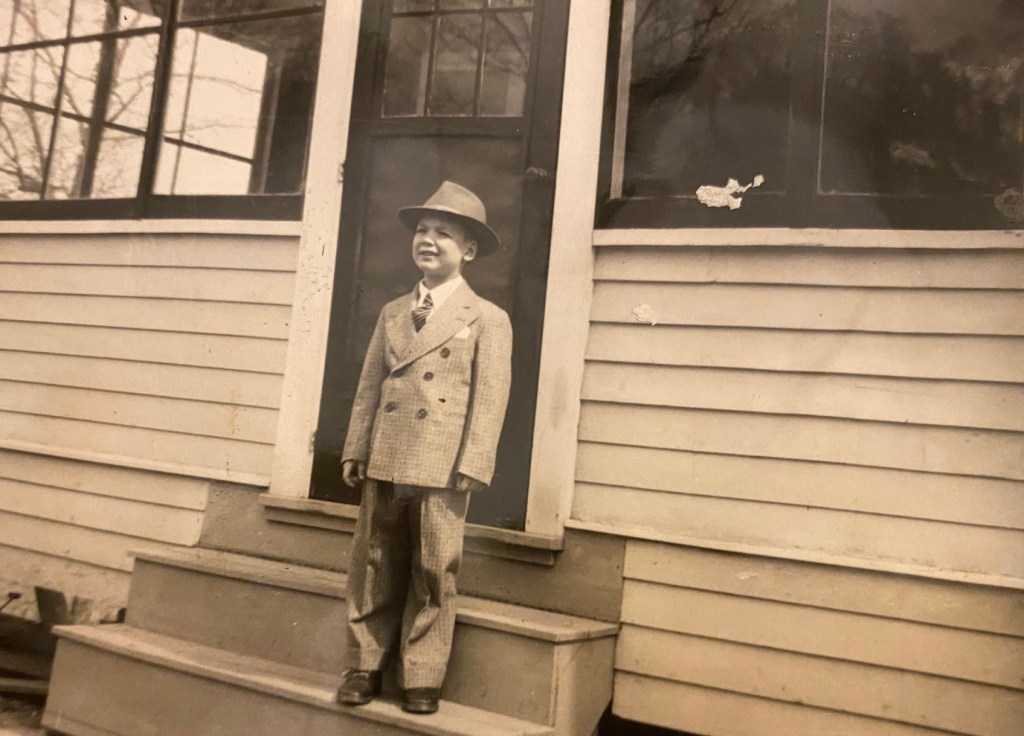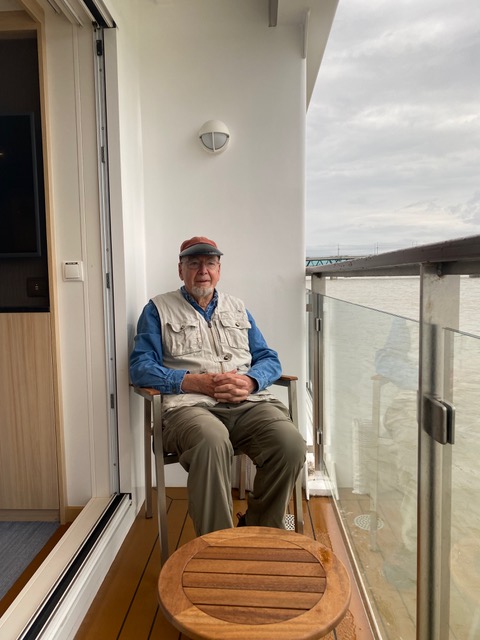
#
“Clothes make the man. Naked people have little or no influence on society.”
—Merle Johnson, paraphrasing Mark Twain
#
I’ve often said that if I were a prehistoric humanoid, I would have been the one to invent clothes, and very rarely does a Christmas go by without my asking for and receiving some new article of attire. This year was no different, and as I opened my present, I began thinking about how the clothes I’ve worn over the years have both reflected my self-image and in turn, shaped it.
My parents, of course, picked my first clothes. They had grown up poor, in what today we call “dysfunctional” families, spending their lives striving to become part of the great American Middle Class. The photograph above shows me at around five years old, probably before heading to church. I suppose I’m cute (although I think I look more like a midget), but I’m also evidence of my parents’ early expectations for me to become an adult with a white-collar job.
Other than vinyl records, the money I earned in high school went towards clothing. Still under the influence of my parents, I was after the “Ivy-league” look: chino pants with a belt in the back, pin-striped shirts, and white or “dirty” (light brown) bucks. These clothes said not only was I going to college, but—far more important to me at the time—that I belonged to the in-crowd of athletes and cheerleaders, unlike my cousins who wore jeans, tee-shirts, and motorcycle boots.
I attended a private high school, but one to which the town had paid tuition until my senior year when it voted to build a public high school. In preparation for the following year when our school would become a private college preparatory facility, the headmaster required all male students to wear coats and ties. In addition, our new basketball coach required that during the season our team wear fedoras or wool alpine hats (mine, as I recall, was dark green, with a plume). I disliked both rules, until I discovered that when our team walked into another school’s gymnasium, the other team found us intimidating. I can’t prove clothing was why we won the Western Maine Basketball Championship, but I doubt if it hurt.
During my senior year, under the influence of a history teacher (referred to by some in town as “that commie in the high school”), I started questioning what he called “middle-class values.” I was also trying to decide what I wanted to do with my life. I spent hours in the guidance office looking at college catalogues. I still remember vividly coming across a colored catalogue. On the cover stood a man with six-foot wide shoulders and a thirty-inch waist, dressed in a red-checked flannel shirt, jeans, and work boots standing by a horse and an Irish setter looking out over a vast expanse of timber-covered mountains. Only after seeing myself in his place did I read the title of the catalogue, “Careers in Forestry.”
What a great way to thumb my nose at conventionality and broaden my shoulders at the same time! By the time I entered the forestry program at the University of Maine the following September, I’d bought six flannel shirts, three pairs of jeans, and a pair of moccasins. (Unfortunately, I couldn’t find a store that sold new shoulders.)
That I was more concerned with the clothes than with the career seems clear when I recall that even after switching my major from forestry to English, I wore the jeans and flannel shirts (none of which ever saw an iron) along with a corduroy sport coat with patches on the elbows. I remained damned if I was going to look like the frat boys and BMOCs in their chinos, sweaters, and penny-loafers.
As I wrote in the last blog, when I became a Graduate Assistant in English at the University of Vermont, I discovered the wonderful new world of academia—an inner sphere of the mind, yes, but also a world in which college professors commanded respect. They appeared (and it took me years to find out appearances can be deceiving) confident, in control. And no one demanded more respect than Stanley Bogart, the Chair of the English Department. Stan was maybe 5’ 6” tall, but I always felt I was looking up at him, primarily I think because he looked as if he’d stepped from a 1968 Esquire magazine: pastel, double-breasted sport coats with matching ties and pocket handkerchiefs or Nehru jackets (if you don’t remember them, look ‘em up), bell bottom pants, and boots with high heels.
When I began teaching at an area high school in the 70s, even as teachers began dressing more and more informally, I emulated Stan, which I found gave me the respect I craved and the confidence I lacked. Putting on one of my flashy sports coats, tying my tie in a Double Windsor, and pinning it with one of my dozen tie-tacks was like putting on a suit of armor before riding out to challenge the dark powers of ignorance.

Until I began to suffocate and left in the middle of the school year to move back to my hometown and marry another woman. I threw away all my ties (except the one I still keep for funerals), grew a beard, and became a “writer.” Still, I cultivated my image—dressed in tan chinos, denim shirts, and a sport coat made from firehose with something like twelve pockets (I still wear it)—that gave me the confidence to apply to an MFA program in creative writing.

When Mary Lee and I began traveling, I started making trips to L.L. Bean for cargo pants, shirts with sunblock, a travel vest, microfiber underwear, and hiking boots. They’re comfortable and they have pockets for all the crap I seem to need to carry, but they also help me see myself as a pilgrim, an adventurer. I often wear them around town or for a walk in the woods, imagining I’m trekking through Scotland or hiking up Mount Kilimanjaro instead of strolling past a duck pond or walking up Arrowhead Drive.

I’ve often come home from my travels with a tee-shirt or sweatshirt: mementos from the journey. Like ancient warriors who used to return with scalps or shrunken heads of their enemies tied around their necks, I wear shirts from “Rick’s Café” in Key West, or “Pike Place Fish” in Seattle when I exercise; they make me proud of my accomplishments and give me more energy.
After buying a travel vest, I bought others: fleece, down, woolen, quilted… They not only have pockets, but they give me all kinds of arm room. Still, if I’m honest, I have to say that my favorites are a vest made in Nepal by Tibetan refugees because I think it helps me meditate, and a leather vest that I wear to go with my fedora when I play the banjo in public.
Looking back over what I’ve written, I can see how clothes have often become costumes, as if I’m in a play—a way to act out my fantasies in a relatively harmless fashion. How clothes can be body masks to hide behind. How clothes give me the illusion of having control over my life.
All of which makes me wonder about this Christmas and the sweatpants and hooded sweatshirt I got.
#

I just love this one, Rick. Women are so often made to feel shallow if clothing holds meaning for them–but of course it does. (I love the title of Ilene Beckerman’s memoir: Love, Loss, and What I Wore. Many happy reflections and ensembles to you!
LikeLiked by 1 person
Thnx heaps, Dina…
LikeLike
Not sure where to comment. Hope this works. Just catching up on a couple of your posts that I missed while I was moving. Loved the clothing – and the photos were great. I liked getting to know the different Ricks that I didn’t know. I loved reliving the different phases. I am totally isolated because of COVID fears and I think every morning when I get up about how little what I wear matters now. It is kind of fun to know that what I am wearing is dictated solely by my state of mind that morning – and the sometimes virtual meetings. I loved the photo of Scott. I think that was from an earlier post. I relate to so much you write about. I think one of the best ways to get through aging is to remain curious. Thanks for your blog. Brenda/Brynna
LikeLike
I love your stories. As a former student and now carrying the label “elder”, I appreciate your perspective. And I appreciate what you taught me, oh so many years ago at MDIHS. I am writing a book in my retirement. Thank you!
LikeLike
Great! Please keep me posted as to your progress. I want a copy of the book when it’s finished!
LikeLike
Maybe you should edit for me! I should send you the Prologue for your critique! Stay well
LikeLiked by 1 person